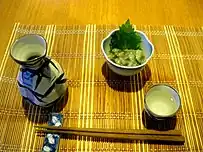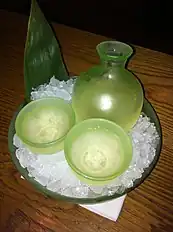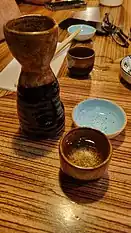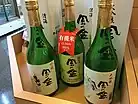< Reconstruction:Proto-Japonic
Reconstruction:Proto-Japonic/sakay
Proto-Japonic
Etymology
Most likely derived from combining form *saka- + *y (emphatic nominal particle). The descendants would merge this vowel pair to /-e/ (Old Japanese e2). Compare the development of *kamuy (“god”).
Descendants
- Old Japanese: 酒 (sake2, saka (< *saka-))
- Japanese: 酒 (sake, saka)
- → Ainu: サケ (sake)
- → Arabic: سَاكِي m (sākī)
- → Armenian: սակե (sake)
- → Belarusian: сакэ́ n (saké)
- → Bengali: সাকে (sake)
- → Bulgarian: саке n (sake)
- → Danish: sake c
- → Dutch: sake m
- → English: saké, sake, saki
- → Esperanto: sakeo
- → Finnish: sake
- → French: saké m
- → Georgian: საკე (saḳe)
- → German: Sake m
- → Greek: σάκε n (sáke)
- → Hebrew: סָאקֶה (sake)
- → Hungarian: szaké
- → Icelandic: sake n
- → Ido: sakeo
- → Indonesian: sake
- → Italian: sakè m
- → Javanese: sake
- → Northern Kurdish: sake f
- → Lithuanian: sakė
- → Macedonian: са́ке n (sáke)
- → Malay: sake
- → Norwegian: sake m
- → Persian: ساکی (sâki)
- → Polish: sake n
- → Portuguese: saqué m, saquê
- → Russian: сакэ́ n (sakɛ́), саке́ n (saké)
- → Spanish: sake
- → Swedish: sake
- → Tagalog: sake
- → Thai: สาเก (sǎa-gee)
- → Ukrainian: саке́ n (saké)
- → Vietnamese: sake
- Japanese: 酒 (sake, saka)
- Proto-Ryukyuan: *sake
References
- Martine Robbeets (2021) Triangulation supports agricultural spread of the Transeurasian languages - see 25Eurasia3anglesynthesisSI5eJaponic.xlsx
- Martin, Samuel E. (1987) The Japanese Language Through Time, New Haven, London: Yale University Press, →ISBN, page 517
- Chihkai Lin (August 2015) A Reconstruction of Old Okinawan: A Corpus-Based Approach, University of Hawaii at Manoa
This article is issued from Wiktionary. The text is licensed under Creative Commons - Attribution - Sharealike. Additional terms may apply for the media files.

.jpg.webp)



